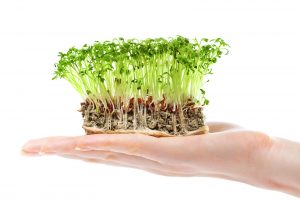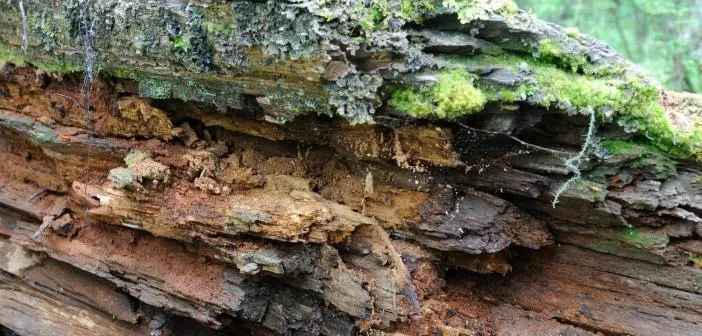What do you do with those large limbs and logs that fall from the trees around your home after a windstorm? Unless you heat your home with wood, chances are you either call a tree service to cut them up and take them away or line them up on the curb for the garbage truck to deal with. Hügelkultur garden beds might be hard to pronounce, but they offer a fantastic way to use those limbs and logs to create an oasis of fertility for your garden and surrounding landscape.

Why Your Garden is Losing Fertility
Most of us have no idea how plants grow. We might vaguely remember some high school biology lesson about photosynthesis and how plants take energy from sunlight and convert it into plant food. Apart from that however, we mostly just hope the soil we sow our seeds into gives plants whatever they need to grow and stay healthy in order to offer us a bountiful harvest.
The soil is undoubtedly a complicated and complex thing. While to the bare eye it may appear to be nothing more than brown or black dirt, there are literally billions of living organisms in every handful of fertile top soil. The fertility from the soil comes from the slow but steady natural process of organic matter falling onto the surface of the ground and decomposed by those billions of creatures that make up the soil community.
The plants we grow send roots into the soil. Those roots pull up nutrients provided by healthy soil. In natural ecosystems, such as forests or prairies, the nutrient balance in soil is continually replenished. The nutrients used by trees, bushes, shrubs, and grasses are given back to the soil when leaves fall or grasses die and slowly reincorporate into the soil.
One of the (many) problems with modern agriculture, however, is that we want our plants to get the nutrients they need from the soil, but we don’t offer nutrients back to the soil itself. Monocultures of grain crops or vegetables grown year after year after year suck up the available nutrients from the healthy soil. After a certain amount of time, that soil is left with zero fertility. The abundant soil organisms gradually begin to die off as the soil essentially “dies”.
In order to grow crops, then, we’re forced to use synthetic fertilizers made from oil which further add to the destruction of the soil. A typical garden that grows annual crops of vegetables or grains is on an inevitable path towards infertility.
What Are Hügelkultur Garden Beds?
The term “hügelkultur” was coined by Austrian permaculturist and organic farmer Sepp Holzer. Holzer inherited a beautiful farm high on the slopes of the Austrian Alps. While the majority of his neighbors thought he was at too high an elevation to grow anything but timber, Holzer utilized the excess timber to create extraordinary amounts of fertile garden beds.
Hügelkultur beds mean hill culture. A hügelkultur bed is essentially a pile of logs and twigs buried underneath soil and covered with a mulch of hay, straw, or other organic material.
Instead of burning the excess wood that comes from your land, hügelkultur beds transform excess wood into high areas of fertility. It is important to use wood from hardwood trees since they bring more beneficial organisms and healthy bacteria and fungus into the decomposition process.
Softwoods like cedar are very hard to break down and invite “brown rot”, a type of fungus that can be detrimental to plant growth.
How Do Hügelkultur Garden Beds Work?
Like all organic matter, wood will slowly decompose into soil. Billions of bacteria, fungus and other creatures will slowly colonize any sort of wood and begin the process of turning it back into top soil.
Hügelkultur beds, then, basically help the soil organisms along their path by giving them a concentrated amount of food material. By placing large amounts of logs, branches, and other woody materials, you are inviting a whole host of different organisms into a specific area.
Buried wood, then is a source of long-term fertility. Whereas mulches and leaf litter are broken down into fertile top soil in a couple of months, it takes years for soil organisms to transform that wood pile into soil.
The good news, however, is you can plant crops into those beds and on top of the slowly decomposing wood piles. The logs and tree limbs in hügelkultur beds act as a slow release fertilizer that will offer fertility for your plants for several years. By covering the hügelkultur beds with top soil, finished compost, and mulch, you are creating a medium where you can immediately plant out almost any sort of crop.
Hügelkultur beds can also retain enormous amounts of water. If you have ever come across a decomposing log in the heart of the woods, chances are it felt moist to the touch, even in the middle of a serious drought.
Wood holds water well, and by creating a garden bed sitting on top of a pile of decomposing logs, you are essentially creating a mini reservoir of water available to your plants, even during extended droughts.

Where to Get Material for Your Hügelkultur Beds?
One of the advantages of living in urban areas of industrialized countries is waste is abundant. Any time a tree limb falls from a wind storm or a tree has to be pruned back due to electrical lines, the wood is taken to the curb side for the garbage truck.
After a significant wind storm, chances are you could easily pick up more than enough wood to build several hundred hügelkultur beds. A simple phone call to your city’s electrical company or municipal tree service should get you access to more than enough raw material.
If you would rather rely on your own trees for your hügelkultur beds, coppice forestry is an easy way to get a steady and sustainable supply of medium sized tree limbs. Coppice forestry is simply the process of cutting fast-growing trees back. These trees have an enormous capacity to send up new growth after being cut back. Coppice forestry, then, allows you to cut back excessive tree growth without killing off trees.
How to Build a Hügelkultur System?
One of the most unique aspects of a hügelkultur system is it allows you to recycle otherwise unwanted wood into an essential part of your agricultural system. Furthermore, hügelkultur beds also allow you to integrate different and diverse design elements in your landscape design.
For example, let’s say you only have a small backyard bordering on a treeline. You could easily gather more than enough fallen wood from the treeline to build a series of raised garden beds. Instead of having to spread compost over those beds every year, however, the slowly decomposing wood from the hügelkultur would provide fertility for several years.
If you lived and farmed on sloped land, hügelkultur could also be integrated into the landscape by placing the mounds of wood on contour across the slope. You could dig swales or drainage ditches above the mounds of wood and use the excavated soil to cover the wood.
If you were planning on building a market garden that was open to the public for a self-pick type of system, you could build a small labyrinth with hügelkultur beds raised 3-4 feet on either side. As your customers wander through the self-pick labyrinth, the hügelkultur beds would both guide them and offer them plentiful amounts of fresh produce to pick.
Whichever design you come up with for your hügelkultur beds, the basic process remains the same. Simply, find a plentiful supply of hardwood limbs and logs. Place those logs and limbs in the area where you want to create a garden bed and cover them with upturned sod, soil, compost, and mulch. You can plant into your hügelkultur bed immediately and reap several years of harvest before having to rebuild your beds.
Hügelkultur Beds for More Productive and Sustainable Gardens
Living sustainably requires us to continually find ways to provide for ourselves while not diminishing the capacity of the natural world to replenish its natural fertility. While growing your own food is certainly a step in the right direction, even the most dutifully tended to garden will eventually lose its fertility after years of growing out annual crops. Hügelkultur allows us a path to grow the food we need while simultaneously contributing to the health and resiliency of the soil that gives us our sustenance.
